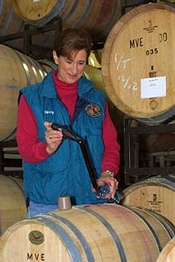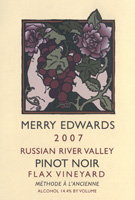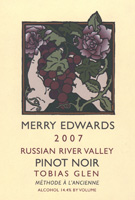Merry Edwards has been called the Queen of Pinot (Reine de Pinot) and with good reason. Edwards, a veteran California winemaker, who  operates out of her eponymous winery in Sebastopol, in western Sonoma County, is considered to be one of the leading experts on California Pinot Noir--which is no mean feat when you count the number of winemakers getting into the Pinot derby of late.
operates out of her eponymous winery in Sebastopol, in western Sonoma County, is considered to be one of the leading experts on California Pinot Noir--which is no mean feat when you count the number of winemakers getting into the Pinot derby of late.
Vineyardist Ken Coopersmith, Edwards’ husband and partner, is no mere consort to the Queen of Pinot, since he is known in wine circles as “Roi de Sauvignon Blanc.” One more mention (I promise) of wine royalty: There is at least one other woman winemaker making a claim to the Pinot crown, although her choice of title outwardly appears to have little to do with wine. Lane Tanner, of Lane Tanner Wines in Santa Maria, refers to herself as the Pinot Czarina. For longer than most Californians care to remember, there has long been a political, economic and social struggle, mostly under the radar, between Northern and Southern California and what we have here might just be another attempt to wrest bragging rights in one part or another in the Golden State.
But that’s a story for another column. My never-ending quest to discover new Pinot Noirs and their makers, while not ignoring the tried and true winemakers, has brought me to the door of the Merry Edwards Winery. For more than two decades, Edwards made wine at Mount Eden and Laurier and when I first met her, she was with Matanzas Creek, in Bennett Valley. She was making Bordeaux-style reds then, though her heart was with Pinot Noir. But Edwards didn’t want to just make Pinot Noir any old way; she wanted to utilize the outstanding grapes being grown in the Russian River Valley, one of the premier regions in California for Pinot.
Vineyard selection is an important part of Edward’s approach to making Pinot Noir. She sources grapes from eight different Russian River Valley Pinot vineyards, four of which are estate (Coopersmith, Cresta d’Oro, Meredith, Georganne), the others under long-term contracts. The current 2007 releases include single vineyard Pinot Noirs from Flax, Coopersmith, Tobias Glen, Klopp Ranch and Meredith Estate. In  an odd bit of irony, and another example of questionable government action, a recently approved regulation will require Merry Edwards and other Sonoma County wineries to redesign their front labels to include the Sonoma County appellation by 2014.
an odd bit of irony, and another example of questionable government action, a recently approved regulation will require Merry Edwards and other Sonoma County wineries to redesign their front labels to include the Sonoma County appellation by 2014.
Why Russian River and not Carneros, Santa Barbara or Anderson Valley for Pinot Noir? “Russian River Valley is unique in its kaleidoscopic fruit character and full rich texture,” says Edwards. She cites the wide summertime temperature swing--as much as 50 degrees from day to night--as a major factor in the production of tannin and color compounds. Would she consider fruit from another noted Pinot Noir growing area? “We are intimately involved in farming our own vineyards and those we purchase from, presently Klopp Ranch and Olivet Lane. With this winegrowing philosophy, it does not make sense for us to purchase fruit from a distant site. Our investment is in the Russian River Valley because we believe this is the best place in the world to grow Pinot Noir.”
Clonal material is commonplace today for a number of varieties and Pinot Noir is no slacker in the clone department. Bring a bunch of Pinot Noir winemakers together and the conversation is likely to veer off into a coded chatter of words and numbers: Pommard, Swan, Martini, Dijon 115, 677, 777, 828, ad infinitum. But is it important to match specific clones to a select vineyard site? “Relatively few clones or field selections make great Pinot Noir. Thus it’s critical to make the ‘right’ choice,” claims Edwards. She adds that Pinot Noir has a high rate of mutation and so it’s important to match the site with the specific clone and not just fall back on what’s currently fashionable.
Fashion is indeed au courant in many Pinot Noir vineyards and you might even say in the winery as well with such popular cellar techniques as pump-over vs. punch-down, oak barrel selection and fermentation processes like “Methode Ancienne” vs. stainless steel.
Reasons for using more traditional fermenting methods with Pinot Noir vary. When asked by British wine writer Jancis Robinson to explain the front label term Methode Ancienne on his Pinot Noir, Ted Bennett, owner of Navarro Vineyards in Mendocino’s Andersen Valley said, “Methode Ancienne is a fancy way to say ’old fashioned way,’ and it refers to the fact that we gently punch down the cap of our fermenting Pinot Noir rather than pumping over. It is a labor intensive way to make Pinot but it helps minimize harsh tannins and enhances the bright fruit.” Merry Edwards says that the method allows her “to pamper the wines a bit more as they are fermented in our smallest three to five ton open-top tanks.” She notes that the designation Methode Ancienne will be phased out by 2014 to make room on the front label for the required Sonoma County appellation.
Edwards uses only open top fermenters, equipped with an automatic punch down device that takes the hard work out of hand punch downs. In the past, the task of pumping over usually fell to a junior cellar rat balancing on a plank across the top of an open fermenter, working a long pole with a flat board on the business end, laboriously punching holes through the dense cap of stems and skins. Today, many wineries have hydraulic punch-down devices that can be moved from tank to tank.
Another “fashionable” technique (and topic) among Pinot Noir producers is oak types and cooperages. Although Edwards has experimented with American oak for Pinot Noir, she doesn’t think it is compatible nor does it enhance the wine. “For our Pinots we use French oak exclusively and all of our Pinots are barrel aged for 10 months.” Edwards uses barrels from as many as eight French cooperages, with percentages of new oak ranging from 55% to 82%. She adds that “each vineyard-designated Pinot Noir has its own ‘favorite’ cooper or mix of coopers that match well with the wine and help enhance or complement specific characters.”
“each vineyard-designated Pinot Noir has its own ‘favorite’ cooper or mix of coopers that match well with the wine and help enhance or complement specific characters.”
Each of Edward’s single vineyard Pinot Noirs has its own personality, usually requiring slightly different techniques in the cellar. Winemakers will often add a percentage of woody stems and/or whole grape clusters (that include stems) to the fermenting mass, believing it adds structure and dimension not usually achieved by fermenting de-stemmed berries. Edwards supplements the Olivet Lane Pinot Noir with about 25-30% whole clusters, but for the Flax she has found that 10% whole cluster is best. Coppersmith and Meredith Estate usually do not have whole cluster additions. For her, it’s a matter of personal preference based on lots of experimenting with different vineyards and different clones.
Most winemakers today would be satisfied just to make wine, but the demands of the modern market require than to do much more. I asked Edwards how she answers the question of comparing California Pinot Noir with French Burgundy. “I feel that comparisons with other regions are not really relevant.” She does allow though that “wines (Pinot Noirs) from California and more specifically from Russian River Valley, are rivaling the French…the wines don’t have to be the same to both be of equal quality. California certainly has a higher value/price ratio than Burgundy.”
Finally, I asked Edwards about competition for Pinot Noir from Syrah and if she thought Pinot Noir was gaining in popularity on Cabernet Sauvignon? “I don’t see Syrah as a contender,” she said. “It seems obvious that Pinot Noir is gaining in popularity compared with Cabernet. Why else are the Napa Cab producers coming to the Russian River Valley and Sonoma Coast?”
Although some of the 2008 Merry Edwards Russian River Valley Pinot Noirs are entering the market now, the highly-vaunted 2007 single vineyard Pinots are currently available. “I can’t think of a previous vintage comparable to 2007,” says Edwards. “Perhaps 2000 or 2003 were somewhat similar. It (2007) was a dream vintage because the high quality of the grapes made winemaking easy. As we were involved with the construction of a new winery that year, an easy vintage was a wonderful thing.”